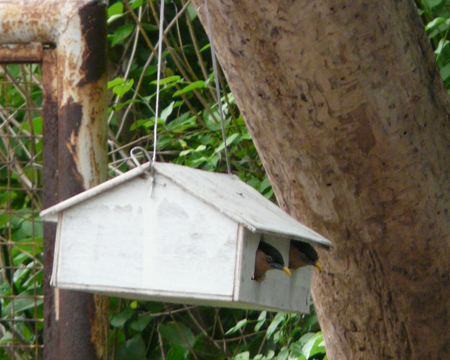
A
NEST IN MY GARDEN
-Suhas Kumar
The nest-box that I built
Looked like a miniature hut
I was doubtful - any bird would ever like it, but
After the summer and after a few showers
when grasses turned green and trees came alive
and a zephyr blew from the east
I got a surprise
I saw one fine morning two brahminy starling arrive
They were on the nest box, into the nest box
sitting inside and peeking trough two holes
like an excited young couple exploring their new home.
The joy I felt today, I had never felt before
even when watching tigers in the jungle galore
The nest box still dangles from the dead zizyphus tree in my garden where I had hung it about 5 months back, but sans a tenant. Many birds – babblers,
coppersmith, koel, crow-pheasant, common myna, sun-bird, magpie robin, Indian robin, ashy wren warbler, brahminy starling and others – visit my garden but none of these birds did display any interest in my nest box till the last Tuesday. That day, after morning
walk, just as I was entering my compound, I gave a furtive glance towards the nest - as I did every day hoping to find some activity there - my heart missed a beat and then swelled with happiness to find a pair of brahminy starlings inspecting the nest box.
The box swayed and circled as the birds sat on it, yet the birds entered the nest, turned around and peeked through the two holes for some time, hopped in and out several times as if they were testing how good this nest would be for their family.
I ran to fetch my camera and within seconds captured both still and video shots of the nest inspection exercise. They flew off suddenly, but I was so happy that the nest I built was evaluated and also for capturing some rare moments on film.
Worried that the birds may be apprehensive of a swaying and gyrating nest and they might not come back, I stabilized it in a fork of the tree with a
piece of wire. I hoped that the birds would return but apparently they were a tough client and went away to inspect few other nest-boxes. I am still hopeful.
15.7.2009
Morning, the birds briefly visited the nest. At around 6.30 PM, not two but three brahminy starlings came this time and sat on the zizyphus tree and
one of them entered the nest. I am certain that the third one was a consultant.
16.7.2009
No sign of birds in the morning.
17.7.2009
8.45 A.M - female came, I saw her depositing a small twig inside the nest-box as if making a reservation as we do on buses and trains by spreading our
hanky on the seat. She, perhaps, felt my prying eyes on her – off she flew. 7.05 PM -No sign of birds in the evening today.
20.7.2009
No sign of birds, I inspected the nest-box today and found a furrow at the joint in the middle of the slanting roof through
which rain water dripped into the interior. I decided to repair it and pasted a plastic sheet over the roof, hoping that the birds would return.